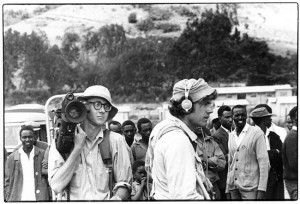JAMES BLUE ARCHIVE OPENING AND LECTURE
Official welcome and a talk by Christina Kovac on Preserving James Blue’s The March
4:00 p.m. Browsing Room, Knight Library Free
 Join us for a brief ceremony in which University of Oregon officials will welcome the deposit of the James Blue Archive in the Special Collections Library by the James and Richard Blue Foundation. This will be followed by a talk by Christina Kovac from the National Archives and Records Administration (NARA). She is the supervisor of the Motion Picture Preservation Lab, which is responsible for performing conservation and preservation work on motion picture records held across NARA. Recently, Kovac completed a digital restoration of The March and has completed HD scanning of the other films directed by James Blue for the United States Information Agency (USIA). Kovac will discuss the photochemical preservation of all of the USIA titles at NARA with special emphasis on the preservation and digital restoration of The March.
Join us for a brief ceremony in which University of Oregon officials will welcome the deposit of the James Blue Archive in the Special Collections Library by the James and Richard Blue Foundation. This will be followed by a talk by Christina Kovac from the National Archives and Records Administration (NARA). She is the supervisor of the Motion Picture Preservation Lab, which is responsible for performing conservation and preservation work on motion picture records held across NARA. Recently, Kovac completed a digital restoration of The March and has completed HD scanning of the other films directed by James Blue for the United States Information Agency (USIA). Kovac will discuss the photochemical preservation of all of the USIA titles at NARA with special emphasis on the preservation and digital restoration of The March.
The March documents the 1963 March on Washington and was released to countries around the world in 1964. Despite this wide reach, the film remained out of the American public eye for decades. In 1986 Congress passed HR 4985 instructing “the Archivist of the United States to provide for the distribution within the United States of the USIA film The March.” At this time the original reels arrived at NARA along with theater copies that could be requested for research or public screenings. This was the extent of the film’s availability until The March was named to the National Film Registry in 2008. After being placed on the registry, requests for access to the film rose. As demand increased, it was evident that all of the reels required full treatment, preservation, and analysis. As part of this work it was evident that the high intrinsic value of the film also warranted a full digital restoration, particularly in light of the 50th anniversary of The March on Washington. Join Christina Kovac as she walks us through the film preservation and restoration process, illuminating the history and importance of the James Blue Archive. Cosponsored with UO Libraries.
KENYA BORAN
With codirector David MacDougall
7:00 p.m. Jordan Schnitzer Museum of Art Lecture Room Free
“Hasn’t the government any work to do? Hasn’t it any camels like us? All the government thinks of is paper!” spouts an impassioned Boran man in fireside conversation with a friend. His friend responds flatly, “It wants all the children to go to school.” Kenya Boran documents the changes that come to a previously insular desert people as Kenya is rapidly developed in the 1970s. A busy new road has split the mountainous upper portion and lowlands of the Boran land, forcing the herding people to adapt to an environment changing without their consent. The Boran people struggle to accept rules of a new government that is ignorant of their long-enduring ways. The film’s second part follows a 16-year-old former herdsman, Peter Boru, as he navigates a boarding school far removed from his people and way of life. Peter’s life is contrasted with that of traditional herdsman Dokata, who remains faithful to the Boran ways.
James Blue and David MacDougall demonstrate their observational expertise in this insightful 1972 documentary. As boldly asked by the Boran people, “Education is for what?” In the face of overwhelming disparities in a developing third world nation, the question is not an easy one to answer. Peter’s completion of boarding school means little in the fledgling Kenyan economy. Dokata’s herding may soon be made impossible. There are no simple answers to the questions posed by Kenya Boran and this impartial work makes no attempt to sway its audience in favor of either the Boran or government intervention. The film’s power lies in its complex treatment of both the people and the issues involved in modernization.
 Kenya-United States, 1972Directed by: James Blue and David MacDougall
Kenya-United States, 1972Directed by: James Blue and David MacDougall